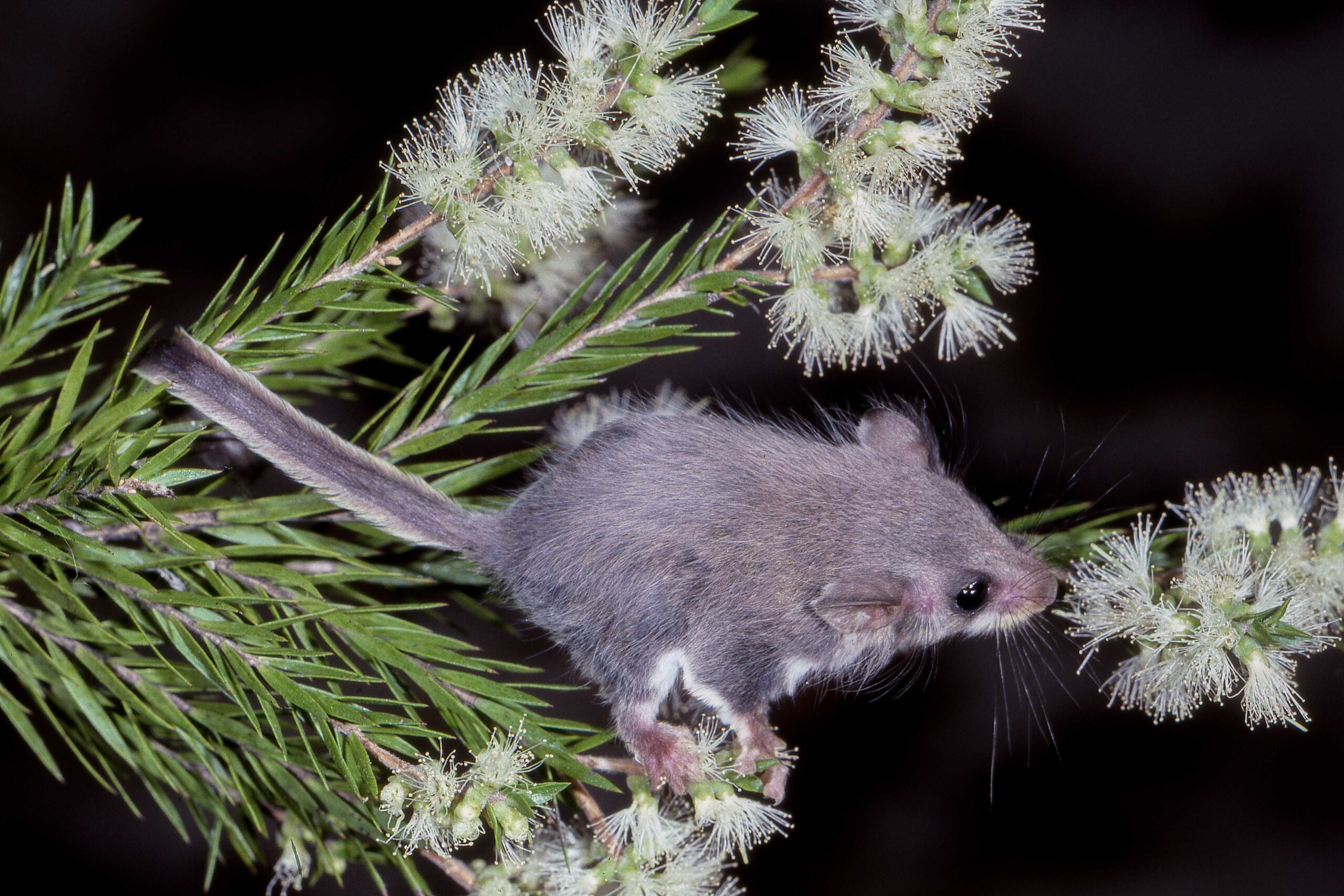High in the canopy of eastern Australia’s forests, a creature no bigger than a mouse glides silently from tree to tree. The Feathertail Glider (Acrobates pygmaeus) is the world’s smallest gliding mammal, a marvel of adaptation that weighs as little as a teaspoon of sugar. With its feather-like tail and skin membranes stretched between limbs, it is a specialist of aerial navigation, thriving in woodlands and forests where agility and lightness offer survival.
Identification
The Feathertail Glider is a tiny marsupial, weighing just 10-15 grams, with a body length of 6-8 cm and a tail of similar length. Its fur is soft grey-brown above and pale underneath. The most distinctive feature is its tail – flattened and edged with stiff, feather-like hairs that provide stability and steering in flight. The gliding membrane (patagium) extends from elbow to knee, allowing glides of up to 25 metres despite its size. Its large eyes give it excellent night vision, while the sharp claws and serrated pads on its toes provide exceptional grip on smooth bark.
Habitat and Distribution
Acrobates pygmaeus is distributed along eastern and southeastern Australia, from northern Queensland through New South Wales, Victoria and into southeastern South Australia. It inhabits a wide range of environments, including wet and dry sclerophyll forests, woodlands and heathlands, often favouring areas with a dense understorey. They shelter in communal nests made of leaves, bark and fur within tree hollows, usually housing small colonies of 5-20 individuals.
Ecological Role
Feathertail Gliders feed on insects, nectar, pollen and plant exudates such as sap and gum. In doing so, they contribute to pollination and insect population control. Their lightweight foraging across canopies ensures minimal impact on vegetation while enabling them to exploit food sources that larger animals cannot. As prey for owls, snakes and predatory mammals, they are part of a delicate balance in forest ecosystems.
Behaviour and Reproduction
These gliders are nocturnal and highly social, nesting communally to conserve warmth during cold weather. They are skilled gliders, able to launch from a tree trunk, spread their patagium and steer precisely using their feathered tail. Their movements are rapid and acrobatic, making them difficult to spot in the wild.
Breeding occurs mainly in spring and summer. Females give birth to up to four tiny young after a gestation of about two weeks. The young develop in the pouch for around 60 days before moving into the nest. Extended parental care continues until they are independent. Like many small marsupials, Feathertail Gliders have short lifespans, averaging only 4-5 years.
Conservation Status
The Feathertail Glider is listed as Least Concern under the Nature Conservation Act 1992 (Queensland). While considered secure across most of its range, its reliance on tree hollows and nectar-rich habitats makes it vulnerable to local decline where land clearing reduces forest complexity.
Threats
Habitat loss and fragmentation through urbanisation, agriculture and logging reduce available nesting hollows and feeding trees. Predation by feral cats and foxes poses significant risk, particularly in fragmented habitats. Altered fire regimes can destroy communal nests and reduce flowering of key plant species. Climate change, by shifting flowering and nectar availability, presents a longer-term threat to food resources.
Conservation Efforts
The Feathertail Glider occurs in many national parks and reserves across its range, benefiting from habitat protection. Installation of artificial nest boxes has proven effective in supporting local populations where hollow-bearing trees are scarce. Conservation programs that maintain continuous canopy corridors and flowering plant diversity are critical for long-term survival. Community awareness and citizen science monitoring projects contribute to understanding and protecting this tiny glider.
Final Thoughts
The Feathertail Glider is proof that size is no measure of ecological significance. As the smallest gliding mammal on Earth, it performs feats of agility that defy its tiny frame, linking trees with delicate aerial paths. Protecting Acrobates pygmaeus requires safeguarding forests at the fine scale – from tree hollows to wildflowers – ensuring that these remarkable creatures continue to drift silently through Australia’s night skies.
Fauna Resources specialises in the safe handling of a range of different fauna species, through safe, effective and ethical fauna solutions. By providing dedicated fauna services, through passionate fauna spotter catchers and fauna specialists, we can support the unique terrestrial ecosystems and rich biodiversity Australia has to offer.
For more information about our specialist fauna services contact Fauna Resources today.
